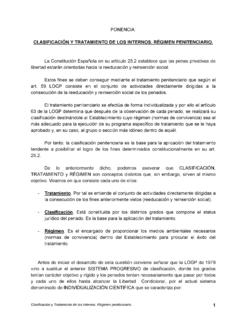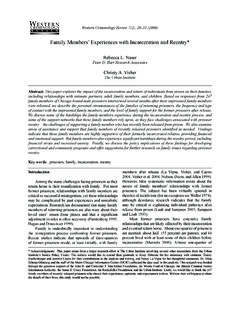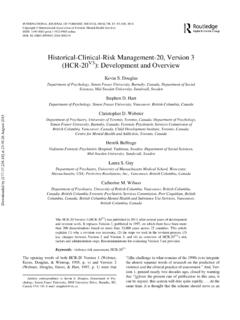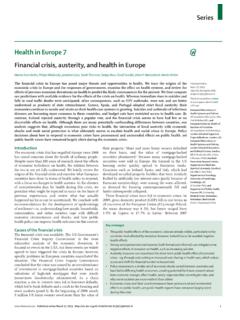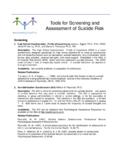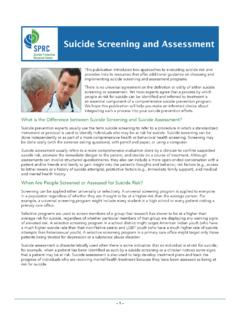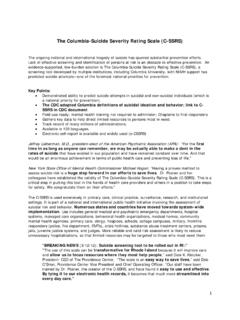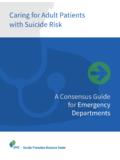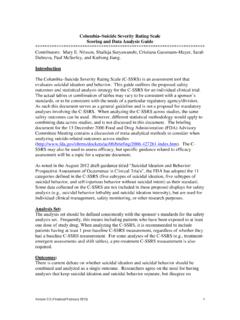Transcription of Clinical Practice Guideline: Suicide Risk Assessment
1 Clinical Practice Guideline: Suicide Risk Assessment Full Version What risk Assessment tools and predictors are effective in screening for self-harm or suicidal ideation during initial Assessment of patients across the life span in the emergency care setting? Authored by the 2012 ENA Emergency Nursing Resources Development Committee Carla Brim, MN, RN, CEN, CNS. Cathleen Lindauer, MSN, RN, CEN. Judith Halpern, MS, RN, APRN. Andrew Storer, DNP, RN, ACNP, CRNP, FNP. Susan Barnason, PhD, RN, APRN-CNS, CEN, CCRN, FAAN. Judith Young Bradford, DNS, RN, FAEN. Sherry Leviner, MSN, RN, CEN. Vicki C. Patrick, MS, RN, SRPN, ACNP, CEN, FAEN. Jean A. Proehl, MN, RN, CEN, CPEN, FAEN. Jennifer Williams, MSN, RN, CEN, CCRN, CNS.
2 2012 Board of Directors Liaison: Deena Brecher, MSN, RN, APRN, ACNS-BC, CEN, CPEN. ENA's Clinical Practice guidelines (CPGs) are developed by ENA members to provide emergency nurses with evidence-based information to utilize and implement in their care of emergency patients and families. Each CPG focuses on a Clinical or Practice -based issue, and is the result of a review and analysis of current information believed to be reliable. As such, information and recommendations within a particular CPG reflect the current scientific and Clinical knowledge at the time of publication, are only current as of their publication date, and are subject to change without notice as advances emerge. In addition, variations in Practice , which take into account the needs of the individual patient and the resources and limitations unique to the institution, may warrant approaches, treatments and/or procedures that differ from the recommendations outlined in the CPGs.
3 Therefore, these recommendations should not be construed as dictating an exclusive course of management, treatment or care, nor does the use of such recommendations guarantee a particular outcome. CPGs are never intended to replace a practitioner's best nursing judgment based on the Clinical circumstances of a particular patient or patient population. CPGs are published by ENA for educational and informational purposes only, and ENA does not approve or endorse any specific methods, practices , or sources of information. ENA assumes no liability for any injury and/or damage to persons or property arising out of or related to the use of or reliance on any CPG. Publication Date: December 2012.
4 Emergency Nurses Association December 2012. Please email for approval to reproduce multiple copies. Table of Contents Page Background/Significance ..1. Methodology ..1. Evidence Table and Other Resources ..3. Glossary of Terms ..3. Summary of Literature Review ..3. Description of Decision Options/Interventions and the Level of Recommendation ..9. Appendix 1 ..11. References ..12. Acknowledgements ..15. Emergency Nurses Association December 2012. Please email for approval to reproduce multiple copies. Background/Significance Suicide is the leading cause of injury mortality in the United States (Rockett, et al. 2012). The Joint Commission National Patient Safety Goal (NPSG) requires facilities to Conduct a risk Assessment that identifies specific patient characteristics and environmental features that may increase or decrease the risk for Suicide (The Joint Commission, 2012, ).
5 The NPSGs require that patients seeking mental health care in general hospitals, for attempted or suspected Suicide attempts and suicidal ideation, are provided with an organized approach for Suicide Assessment and triage (Jacobs, 2007). Individuals who attempt Suicide or have suicidal ideations can present multiple challenges for emergency care providers. Patients often do not volunteer that their injuries are due to self-harm. Care providers need to have a high level of suspicion and attempt to identify potential risk factors and personal characteristics that are associated with suicidal behaviors. Although tools are available to help with assessing potentially suicidal patients, the tools often have limitations for use in the setting of initial Assessment in an emergency department (ED).
6 Once a person is identified as a potential Suicide risk, care providers need to provide safety and preventive care until the patient can be transferred to an area or facility that can provide further psychiatric evaluation and services (Jacobs, 2007; Knesper, 2011). This Clinical Practice Guideline (CPG) evaluates the scientific and research literature for the initial Assessment and evaluation of patients who present to the emergency setting who have suicidal ideation or after attempted Suicide and/or those patients at high risk for future attempts of Suicide . The CPG evaluates screening tools and scales used to assess potential suicidal patients and predictors of Suicide risk for emergency patients.
7 Methodology This CPG was created based on a thorough review and critical analysis of the literature following ENA's guidelines for the Development of Clinical Practice guidelines . Via a comprehensive literature search, all articles relevant to the topic were identified. The following resources were searched: PubMed, Google Scholar, Medical Literature Analysis and Retrieval System Online (MEDLINE), Cumulative Index to Nursing and Allied Health Literature (CINAHL), OVID, TRIP Data Base, HAPI, Cochrane - British Medical Journal, Agency for Healthcare Research and Quality (AHRQ; ), and the National Guideline Clearinghouse ( ). Searches were conducted using a variety of different search term combinations.
8 These included initial psychiatric emergencies, behavioral health emergency and mental health emergency. Additional search terms were Assessment , management with the filters and . and or added. Finally, the topics searched included Suicide , suicidal ideation, Suicide Assessment , Suicide scales and/or tools, and Suicide predictors. Initial searches were limited to English language articles from 2000-2012. The reference lists in the selected articles were hand searched for additional pertinent references. Research articles from ED settings, non- ED settings, emergency care settings, position statements and guidelines from other sources were also reviewed. Articles that did not address the PICO question were excluded for the purpose of this systematic review of evidence.
9 Other articles that evaluated specific medications or mental health pathology, such as schizophrenia were not included. Articles that met the following criteria were chosen to formulate the CPG: research studies, meta-analyses, systematic reviews, and existing guidelines relevant to the topic of Suicide risk Assessment . The CPG authors used a standardized reference table to collect information and assist with preparation of tables of evidence ranking each article in terms of the level of Emergency Nurses Association December 2012. E-mail for approval to reproduce multiple copies. 1. evidence, quality of evidence, and relevance and applicability to Practice . Clinical findings and levels of recommendations regarding patient Assessment were then made by the 2012.
10 Emergency Nursing Resources Development Committee according to ENA's classification of levels of recommendation for Practice , which include: Level A High, Level B Moderate, Level C. Weak or Not recommended for Practice (Table 1). Table 1. Levels of Recommendation for Practice Level A recommendations: High Reflects a high degree of Clinical certainty Based on availability of high quality level I, II and/or III evidence available using Melnyk & Fineout- Overholt grading system (Melnyk & Fineout-Overholt, 2005). Based on consistent and good quality evidence; has relevance and applicability to emergency nursing Practice Is beneficial Level B recommendations: Moderate Reflects moderate Clinical certainty Based on availability of Level III and/or Level IV and V evidence using Melnyk & Fineout-Overholt grading system (Melnyk & Fineout-Overholt, 2005).

